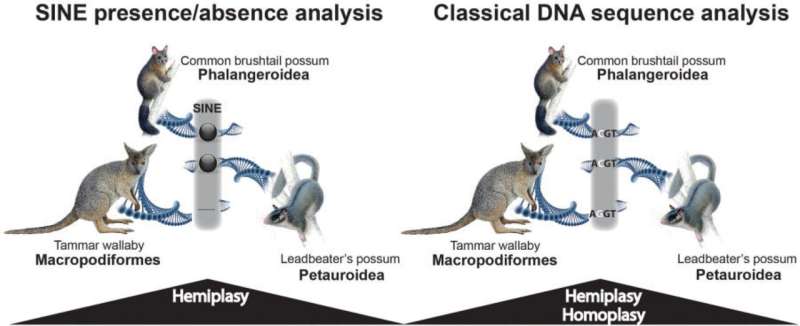Scientific team reveals the correct evolutionary relationships among possums

The brushtail possum asked the sugar glider, "Are we related?" For many years, science answered "No". For a long time, genetic data provided evidence that the Australasian possums, the Phalangeroidea (including the brushtail possum) and Petauroidea (including the sugar glider), were divided into two phylogenetic branches without common ancestry.
But, the research group of Dr. Jürgen Schmitz and Dr. Liliya Doronina from the Institute of Experimental Pathology at the University of Münster (WWU) recently found just the opposite. "Following our analyses of jumping genes, it is clear that all possums share a common ancestry," says Schmitz. In the past, morphological data had already hinted at a common origin of Phalngeroidea and Petauroidea, but DNA sequence analyses challenged and undermined these results.
In contrast to previous genetic-based studies that examined gene sequences, we analyzed the more reliable insertions of jumping genes. Especially, short interspersed elements (SINEs), which a reliable source for resolving evolutionary relationships among species. "If we find a jumping gene in two species at the exact genomic location, we can be sure they are closely related, as such insertions do not happen by chance," Schmitz explained.
The team analyzed complete genomes from 12 different marsupials, enabling them to investigate thousands of genomic positions. Among these, they found 61 genomic insertions of jumping genes at the exact locations in the genomes of all possum families. "These genetic markers demonstrate that all the various possums evolved from a shared ancestor," says Doronina.
The team traveled back 50 million years to clarify this important part of marsupial evolutionary history. Sometimes it is necessary to shake up old scientific ideas to save the biodiversity of species. About 8% of all Australian species became endangered in the last five years. Such animals can be better recognized and protected to retain biodiversity after a reliable estimation of their relatedness.
The research is published in Systematic Biology.
More information: Liliya Doronina et al, Reunion of Australasian Possums by Shared SINE Insertions, Systematic Biology (2022). DOI: 10.1093/sysbio/syac025
Journal information: Systematic Biology
Provided by University of Münster


















